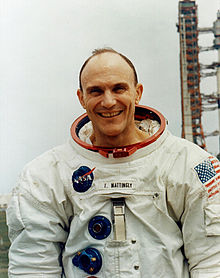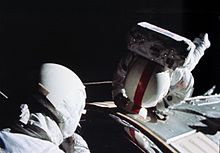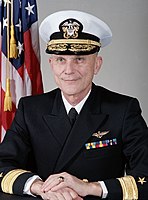Ken Mattingly
Ken Mattingly | |
|---|---|
 Mattingly in 1971 | |
| Born | Thomas Kenneth Mattingly II March 17, 1936 |
| Died | October 31, 2023(aged 87) Arlington, Virginia,U.S. |
| Education | Auburn University(BS) |
| Spouse |
Elizabeth Dailey (m.1970) |
| Children | 1 |
| Awards | NASA Distinguished Service Medal |
| Space career | |
| NASA astronaut | |
| Rank | Rear Admiral,USN |
Time in space | 21d 4h 34m |
| Selection | NASA Group 5 (1966) |
TotalEVAs | 1 |
Total EVA time | 1h 23m |
| Missions | |
Mission insignia | |
| Retirement | June 1985 |
Thomas Kenneth Mattingly II(March 17, 1936 – October 31, 2023) was an Americanaviator,aeronautical engineer,test pilot,rear admiralin theUnited States Navy,andastronautwho flew onApollo 16andSpace ShuttleSTS-4andSTS-51-Cmissions.
Mattingly was scheduled to fly on theApollo 13mission, but three days before launch, he was replaced byJack Swigertbecause he was exposed toGerman measles(which Mattingly did not contract). Mattingly flew asCommand Module Pilotfor Apollo 16 and made 64 lunar orbits,[1]making him one of24 people to fly to the Moon.[2]Mattingly and his Apollo 16 commander,John Young,are the only people to have flown to theMoonand also a Space Shuttle mission. (Fred Haise,Mattingly's originally scheduled crewmate for Apollo 13, performed atmospheric flight testing of the Space ShuttleApproach and Landing Tests.)
During Apollo 16's return flight to Earth, Mattingly performed anextravehicular activity(EVA) to retrieve film cassettes from the exterior of the spacecraft, thecommand and service module.It was the second "deep space" EVA in history, at great distance from anyplanetary body.As of 2023,[update]it remains one of only three such EVAs which have taken place, all during theApollo program'sJ-missions.[3]
Early life and education
[edit]Thomas Kenneth Mattingly II was born on March 17, 1936, in Chicago, Illinois, to Thomas Kenneth Mattingly (1903–1995) and Constance Mason Mattingly (néeClarke;1905–1997).[4][5]His father, who had been hired byEastern Airlinessoon after his son's birth, moved the family toHialeah, Florida.Aviation became part of Mattingly's life from a very young age; he later recalled that his "earliest memories...all had to do with airplanes".[6]
Mattingly was active in theBoy Scouts of Americawhere he achieved its second highest rank,Life Scout.He graduated fromMiami Edison High Schoolin 1954, and went on to receive aBachelor of Sciencedegree inAeronautical EngineeringfromAuburn Universityin 1958.[6]He was also a member ofDelta Tau Deltafraternity (Epsilon Alpha chapter).[7]
Military career
[edit]Mattingly was commissioned in the U.S. Navy as anensignin 1958 and received hisaviator wingsin 1960. He was then assigned toAttack Squadron Thirty-five (VA-35)atNaval Air Station Oceana,Virginia, and flewDouglas A-1H Skyraiderpropeller aircraft aboard theaircraft carrierUSSSaratogafrom 1960 to 1963. In July 1963, he was transferred to Heavy Attack Squadron Eleven (VAH-11) atNaval Air Station Sanford,Florida, where he flewDouglas A-3B Skywarriorjet aircraft for two years and deployed aboardUSSFranklin D. Roosevelt.[2]
While Mattingly was based at Sanford, a fellow officer invited him along on a mission to take aerial photos of theCape Canaverallaunch ofGemini 3(carrying Mattingly's future Apollo 16 Commander John W. Young) from the air.[8]
During his second cruise, Mattingly attempted to join theUnited States Naval Test Pilot SchoolatNaval Air Station Patuxent River,but the cruise ended after the class started. However, he was selected to attend theU.S. Air Force Aerospace Research Pilot SchoolatEdwards Air Force Basein California,[8]where future astronautsEdgar MitchellandKarol J. Bobkowere his classmates and his instructors includedCharles Duke,his Apollo 16 crewmate, andHenry W. Hartsfield Jr.,whom Mattingly later commanded on STS-4.
NASA career
[edit]
Selection and training
[edit]On September 10, 1965, NASA began the selection process for thefifth astronaut group.From a pool of 351 applicants, NASA picked 159 candidates who met the basic qualifications, including beingUnited States citizensborn on or after December 1, 1929, who were no more than six feet tall. They were also required to have at least 1,000 hours of flight time in jet aircraft. Mattingly had previously shown little interest and inclination to apply for the astronaut program, but his views changed at the Air Force Test Pilot School where he and his classmates were offered the chance to apply for eitherNASAor theUnited States Air Force(USAF)Manned Orbiting Laboratoryprogram. Mattingly and Mitchell chose the latter and were rejected. The deadline for applying for the NASA group had passed, but one of their instructors was able to get NASA to accept their applications.[8]On the interview panel the astronaut office representatives were John W. Young andMichael Collins,who were at that time in training as prime crew forGemini 10.Mattingly later recollected that he was "perplexed" by Young. Collins asked Mattingly how he felt about theLockheed F-104 Starfighter,to which Mattingly replied that he thought it was a "fun aircraft" but without worth in combat. Collins appeared to dislike the answer and Mattingly felt he had blown his chance. However, after the conclusion of the selection process, Mattingly was called by NASA's Director of Flight Crew OperationsDeke Slaytonwith an offer to become an astronaut.[8]
At the time of his selection, Mattingly had 2,582 hours of flight experience, including 1,036 hours in jet aircraft. He also had a bachelor's degree in engineering or in the physical or biological sciences as required by the initial qualifications. From the 100 military personnel and 59 civilian candidates, NASA selected 19 to join the group for training as astronauts.[9]
Mattingly, a lieutenant in the Navy,[9]was a student at the U.S. Air Force Aerospace Research Pilot School at Edwards AFB, California, when NASA selected him as an astronaut in April 1966.[2][10]
Apollo 8 and Apollo 11
[edit]
At first, Mattingly was part of the support crew forApollo 8.[11]Mattingly served asCAPCOMduring Apollo 8's second television transmission and subsequent preparation fortrans-Earth injection.[12]
Mattingly then trained in parallel withBill AndersforApollo 11as backup command module pilot, because Anders was going to retire from NASA in August 1969 and, in case of mission delay, would be unavailable.[8]
Apollo 13
[edit]Mattingly was to be the Command Module Pilot on theApollo 13mission. Originally,Jim Lovell,Mattingly andFred Haisewere scheduled to fly onApollo 14but his crew was switched to Apollo 13 so that the commander of the other crew,Alan Shepard,who was grounded duringProject Geminicould train longer. Three days prior to launch, he was removed from the mission because he had been exposed toGerman measles(which he never contracted) and was replaced by the backup CM pilot,Jack Swigert.[13]As a result, he missed the dramatic in-flight explosion that crippled the spacecraft.[14]However, Mattingly played a large role in helping the crew solve the problem of power conservation during re-entry.[13][15]
Apollo 16
[edit]
The swapout from Apollo 13 placed Mattingly on the crew that flewApollo 16(April 16–27, 1972), the fifth crewed lunar landing mission. The crew includedJohn Young(Commander), Mattingly (Command Module Pilot), andCharlie Duke(Lunar ModulePilot). The mission assigned to Apollo 16 was to collect samples from the lunar highlands near the craterDescartes.While inlunar orbitthe scientific instruments aboard the Command/Service ModuleCasperextended the photographic and geochemical mapping of a belt around the lunar equator. A combined total of 26 separate scientific experiments were conducted in lunar orbit and during cislunar coast.[2]
During the return leg of the mission, Mattingly carried out anextravehicular activity(EVA) to retrieve film and data packages from the science bay on the side of the service module. Although the mission of Apollo 16 was terminated one day early out of concern over several spacecraft malfunctions, all major objectives were accomplished.[2]
Space Shuttle flights
[edit]Following his return to Earth, Mattingly served in astronaut managerial positions in theSpace Shuttledevelopment program.[2]
Mattingly was named to commandSTS-4,the fourth and final orbital test flight of theSpace ShuttleColumbia,launched fromKennedy Space Center,Florida, on June 27, 1982, withHenry W. Hartsfield Jr.,as the pilot. This seven-day mission was designed to further verify ascent and entry phases of shuttle missions; perform continued studies of the effects of long-term thermal extremes on the orbiter subsystems; and conduct a survey of orbiter-induced contamination on the orbiter payload bay. Additionally, the crew operated several scientific experiments located in the orbiter's cabin and in the payload bay. These experiments included the Continuous Flow Electrophoresis System experiment designed to investigate the separation of biological materials in a fluid according to their surface electrical charge.[2][16]This experiment was a pathfinder for the first commercial venture to capitalize on the unique characteristics of space. The crew is also credited with effecting an in-flight repair which enabled them to activate the first operational "Getaway Special"(composed of nine experiments that ranged fromalgaeandduckweedgrowth in space tofruit flyandbrine shrimpgenetic studies). STS-4 completed 112 orbits of the Earth before landing atEdwards Air Force Base,California, on July 4, 1982.[2]Mattingly and Hartsfield were greeted by PresidentRonald Reaganafter the landing; Reagan recognized the pair, both graduates ofAuburn University,as "you two sons of Auburn" in his welcoming speech.[17]
STS-51-C,the first Space ShuttleDepartment of Defensemission, launched from Kennedy Space Center, Florida, on January 24, 1985. The crew included Mattingly (spacecraft commander),Loren Shriver(pilot),James BuchliandEllison Onizuka(Mission Specialists), andGary Payton(DODPayload Specialist). STS-51-C performed its DOD mission which included deployment of a modified Inertial Upper Stage (IUS) vehicle from theSpace ShuttleDiscovery.Landing occurred on January 27, 1985.[2]
-
Mattingly (foreground) withHenry Hartsfieldsalutes PresidentRonald Reagan,next to First LadyNancy Reagan,after the STS-4 landing on July 4, 1982
-
"President Ronald Reagan chats with NASA astronauts Henry Hartsfield and Thomas Mattingly on the runway as first lady Nancy Reagan scans the nose of Space ShuttleColumbiafollowing its Independence Day landing at Edwards Air Force Base on July 4, 1982. "[18]
-
Mattingly in his Navy uniform in 1985
Post-NASA career
[edit]In 1985, Mattingly retired from NASA, then retired from the Navy the following year with the two-star rank ofRear admiral (upper half),and entered theprivate sector.He worked as aDirectorinGrumman's Space Station Support Division. He then headed the Atlas booster program forGeneral Dynamicsin San Diego, California.[19]AtLockheed Martinhe was vice president in charge of theX-33development program.[11]He then worked at Systems Planning and Analysis inVirginia.[20]
Mattingly logged 7,200 hours of flight time, including 5,000 hours injet aircraft.[2]
Mattingly was a member of many organizations. He was an associate fellow,American Institute of Aeronautics and Astronautics;fellow,American Astronautical Society;and member,Society of Experimental Test Pilots,and theU.S. Naval Institute.[2]
Personal life and death
[edit]In 1970, he married Elizabeth Dailey.[13]They had one child.[21]
Mattingly died inArlington, Virginia,on October 31, 2023, at age 87.[22][23]NASA announced his death two days later on November 2.[22]
Awards and honors
[edit]Mattingly was a recipient of numerous awards. He was awarded theNASA Distinguished Service Medal(2);[24]Johnson Space Center Certificate of Commendation (1970); JSC Group Achievement Award (1972);Navy Distinguished Service Medal;Navy Expeditionary Medal;National Defense Service Medal;NASA Space Flight Medal;Navy Astronaut Wings;Society of Experimental Test PilotsIvan C. Kincheloe Award(1972);Delta Tau DeltaAchievement Award (1972); Auburn Alumni Engineers Council Outstanding Achievement Award (1972); American Astronautical Society Flight Achievement Award for 1972;AIAAHaley Astronautics Award for 1973;Fédération Aéronautique Internationaleawarded him theV. M. KomarovDiploma in 1973;Department of Defense Distinguished Service Medal(1982).[2]
Mattingly was inducted with a group of Apollo astronauts into theInternational Space Hall of Famein 1983.[25]He was one of 24 Apollo astronauts who were inducted into theU.S. Astronaut Hall of Famein 1997.[26]His name also appears onThe Astronaut MonumentinHúsavík,Iceland, commemorating 32 Apollo astronauts who were sent to Iceland for geological training in the 1960s.[27]
In media
[edit]Mattingly was portrayed byGary Sinisein the 1995 movieApollo 13and byŽeljko Ivanekin the 1998HBOminiseriesFrom the Earth to the Moon.[28]Interviews with Mattingly were also used as part of the narrative track on the 1989 documentary filmFor All Mankind.[29]
References
[edit]- ^NASA Apollo 16 summary page
- ^abcdefghijkl"Astronaut Bio: Thomas K. Mattingly II"(PDF).NASA. January 1987.RetrievedApril 14,2021.
 This article incorporates text from this source, which is in thepublic domain.
This article incorporates text from this source, which is in thepublic domain.
- ^LePage, Andrew (December 17, 2017)."A History of Deep Space EVAs".drewexmachina.
- ^"Mattingly, Thomas Kenneth, II".Naval History and Heritage Command. May 5, 1972.RetrievedDecember 15,2019.
- ^"Thomas Kenneth Mattingly: Illinois, Cook County, Birth Certificates, 1871–1940".FamilySearch.RetrievedDecember 15,2019.
- ^abShayler, David J.; Burgess, Colin (June 19, 2017).The Last of NASA's Original Pilot Astronauts: Expanding the Space Frontier in the Late Sixties.Springer. pp. 53–54.ISBN978-3-319-51014-9.
- ^"Famous Delts".Delta Tau Delta. Archived fromthe originalon May 15, 2010.RetrievedAugust 19,2010.Retrieved February 19, 2012
- ^abcdeWright, Rebecca (November 6, 2001)."Thomas K. Mattingly II".NASA Johnson Space Center Oral History Project.NASA.Archivedfrom the original on May 3, 2021.RetrievedMay 3,2021.
- ^ab"Newly-Selected Group of 19 Astronauts Reports Next Month for Duty"(PDF).NASA. April 15, 1966. pp. 4–5. Archived fromthe original(PDF)on April 13, 2009.RetrievedDecember 9,2019.
 This article incorporates text from this source, which is in thepublic domain.
This article incorporates text from this source, which is in thepublic domain.
- ^Thompson, Ronald (April 5, 1966)."19 New Spacemen Are Named".The High Point Enterprise.High Point, North Carolina. p. 2A – via Newspapers.
- ^abHowell, Elizabeth (April 16, 2013)."Ken Mattingly: Apollo 16 Astronaut".Space.Future plc.Archivedfrom the original on May 3, 2021.RetrievedMay 3,2021.
- ^Lovell & Kluger 1994,p. 54.
- ^abcRensberger, Boyce (April 17, 1972)."Thomas Kenneth Mattingly 2d".The New York Times.p. 24.RetrievedDecember 10,2019.
- ^"Biographical Data: John L. Swigert, Jr., NASA astronaut (deceased)"(PDF).Lyndon B. Johnson Space Center.NASA. January 1983.RetrievedDecember 9,2019.
 This article incorporates text from this source, which is in thepublic domain.
This article incorporates text from this source, which is in thepublic domain.
- ^Lovell, Jim; Kluger, Jeffrey (1994).Apollo 13.Boston: Houghton Mifflin. p. 287.ISBN978-0-618-61958-0.
- ^Snyder, Robert S.; Rhodes, Percy H.; Miller, Teresa Y. (October 1987)."Continuous flow electrophoresis system experiments on shuttle flights STS-6 and STS-7"(PDF).NTRS – NASA Technical Reports Server.NASA.Archived(PDF)from the original on May 3, 2021.RetrievedMay 3,2021.
- ^"Remarks at Edwards Air Force Base, California, on Completion of the Fourth Mission of the Space Shuttle Columbia".Ronald Reagan Presidential Library and Museum.RetrievedJanuary 20,2018.
- ^"Independence Day at NASA Dryden - 30 Years Ago".NASA. July 3, 2012.RetrievedNovember 11,2017.
- ^"International Space Hall of Fame: Thomas K. Mattingly II".New Mexico Museum of Space History. 2005.RetrievedNovember 4,2023.
- ^"Ken Mattingly, who launched to the moon on Apollo 16, dies at 87".Collect Space.November 2, 2023.RetrievedNovember 4,2023.
- ^Hero, Basil (April 2, 2019).The Mission of a Lifetime: Lessons from the Men Who Went to the Moon.Grand Central Publishing. p. 243.ISBN978-1-5387-4850-3.
- ^abDonaldson, Abbey (November 2, 2023)."NASA Administrator Remembers Apollo Astronaut Thomas K. Mattingly II"(Press release).NASA.
- ^Goldstein, Richard (November 2, 2023)."Ken Mattingly, Astronaut Scrubbed From Apollo 13, Is Dead at 87".The New York Times.
- ^"National Aeronautics and Space Administration Honor Awards".RetrievedMarch 24,2012.
- ^Sheppard, David (October 2, 1983)."Space Hall Inducts 14 Apollo Program Astronauts".El Paso Times.El Paso, Texas. p. 18 – via Newspapers.
- ^Meyer, Marilyn (October 2, 1997)."Ceremony to Honor Astronauts".Florida Today.Cocoa, Florida. p. 2B – via Newspapers.
- ^"Apollo astronauts revisit training area in Iceland and explore a new lava flow – The Exploration Museum".explorationmuseum.Archived fromthe originalon April 2, 2019.RetrievedAugust 9,2015.
- ^"Ken Mattingly (Character)".IMDb.RetrievedJune 2,2012.
- ^"For All Mankind – Criterion UHD Blu-ray Review".Home Theater Forum.May 4, 2022.RetrievedNovember 4,2023.
Further reading
[edit]- "T. K. Mattingly Oral History Interviews".Johnson Space Center Oral History Project.NASA.
External links
[edit]- Ken Mattingly
- 1936 births
- 1972 in spaceflight
- 1982 in spaceflight
- 1985 in spaceflight
- 2023 deaths
- 20th-century American businesspeople
- American aerospace engineers
- American test pilots
- Apollo 13
- Apollo 16
- Apollo program astronauts
- Auburn University alumni
- Aviators from Illinois
- Engineers from Illinois
- Military personnel from Chicago
- People from Hialeah, Florida
- Recipients of the Defense Distinguished Service Medal
- Recipients of the NASA Distinguished Service Medal
- Space Shuttle program astronauts
- Spacewalkers
- U.S. Air Force Test Pilot School alumni
- United States Astronaut Hall of Fame inductees
- United States Naval Aviators
- United States Navy astronauts
- United States Navy rear admirals (upper half)


!["President Ronald Reagan chats with NASA astronauts Henry Hartsfield and Thomas Mattingly on the runway as first lady Nancy Reagan scans the nose of Space Shuttle Columbia following its Independence Day landing at Edwards Air Force Base on July 4, 1982."[18]](https://upload.wikimedia.org/wikipedia/commons/thumb/9/93/Ronald_and_Nancy_Reagan_NASA_1982.jpg/200px-Ronald_and_Nancy_Reagan_NASA_1982.jpg)
